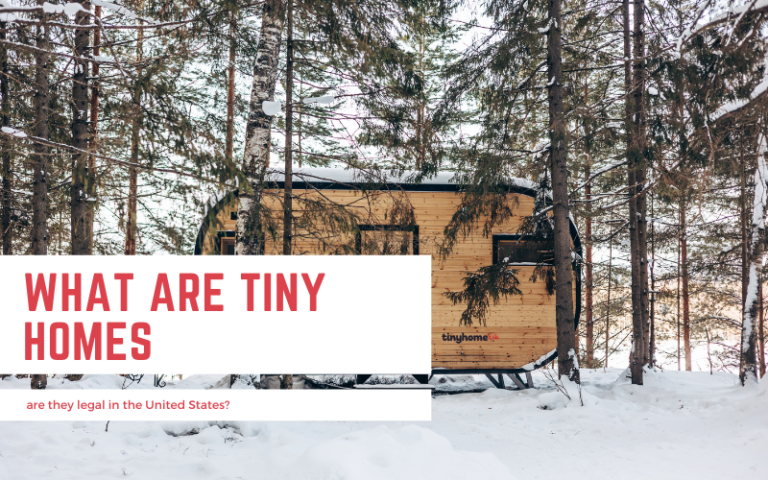Are Tiny Homes Legal in California? Exploring the Regulations and Requirements
In recent years, tiny homes have been gaining popularity as a more affordable and sustainable housing option.
However, many people wonder if it is legal when it comes to living in a tiny home in California.
The answer is yes, but with some regulations that must be followed.
In California, there are two main ways to legally live in a tiny home.
The first is obtaining a special use permit, which allows for the construction of a tiny home on a property that is zoned for a single-family home.
The second option is to connect the tiny home to an RV park, where it can legally be considered an RV and, therefore, allowed to be parked and lived in.
It is important to note that while tiny homes are generally legal in California, there are certain areas where they are not permitted as permanent residences.
Zoning and building codes vary by city, so it is essential to familiarize oneself with the regulations of the specific area where the tiny home will be located.
Understanding Tiny Homes
Tiny homes are becoming increasingly popular in California, but there are some regulations to follow to live in them legally.
In California, a tiny home is defined as a structure intended for separate, independent living quarters for one household that meets specific requirements.
To be considered a legal tiny home in California, the structure must be licensed and registered with the California Department of Motor Vehicles and meet ANSI119.2 or 119.5 requirements.
It must also be towable by a bumper hitch, frame-towing hitch, or fifth-wheel connection.
There are two main ways to live legally in a tiny home in California: by obtaining a special use permit or connecting your tiny home to an RV park.
It is important to note that each city and county may have different regulations, so it is essential to research and comply with local laws.
One benefit of tiny homes is their affordability, as they are typically less expensive than traditional homes.
They also have a smaller environmental impact, requiring less energy to heat and cool and using fewer resources during construction.
However, there are also some challenges to living in a tiny home.
They may not be suitable for families with children or individuals who require a lot of space.
Additionally, finding a place to park a tiny home can be difficult, as many cities and neighborhoods have zoning laws restricting their location.
Overall, while tiny homes are a viable option for some individuals, it is important to research and comply with local regulations before deciding to live in one.
California State Laws and Tiny Homes
Tiny homes are becoming increasingly popular in California, but are they legal? The answer is not straightforward, as regulations vary by city and county.
However, some state laws apply to tiny homes in California.
Accessory Dwelling Units (ADUs)
California implemented new state-mandated ADU laws on January 1st, 2020.
The California Health and Safety Code (HSC), Section 65583 (c) (7), requires that cities and counties develop a plan that incentivizes and promotes the creation of ADUs that can be offered at affordable rent for very low to moderate-income households.
This means that if a tiny home meets the requirements of an ADU, it may be legal to live in as long as it is used as an ADU and not a primary residence.
Minimum Square Footage Requirements
California has minimum square footage requirements for dwellings, including tiny homes.
According to the state building code, a dwelling must have at least 120 square feet of living space, with at least one room that measures at least 70 square feet.
However, some cities and counties have their own minimum square footage requirements that may be higher.
Building Codes and Permits
Tiny homes in California must comply with the state building code and obtain the necessary permits before construction.
However, building codes and permit requirements may vary by city and county.
Researching local regulations before building or living in a tiny home is important.
Zoning Laws
Zoning laws also vary by city and county and may affect the legality of tiny homes.
Some areas may allow tiny homes as long as they are used as ADUs, while others may prohibit them altogether.
It is important to check local zoning laws before building or living in a tiny home.
In summary, the legality of tiny homes in California depends on various factors, including local regulations, building codes, and zoning laws.
Researching and complying with all applicable laws before building or living in a tiny home is important.
Zoning Regulations
Zoning regulations for tiny homes in California vary by city and county.
It is important to familiarize yourself with your location’s zoning and building codes before building or living in a tiny home.
Here are some general guidelines to keep in mind:
- Tiny homes on wheels (THOWs) are not allowed as permanent residences in all cities and counties. However, some areas allow them as accessory dwelling units (ADUs) or temporary housing.
- Foundation-type tiny homes may be allowed as ADUs or primary residences, but they must comply with California Building Codes (CBC) and local zoning regulations.
- Some cities and counties have minimum square footage requirements for residences, which may make it difficult to legally live in a tiny home. However, some areas have exceptions for ADUs and alternative housing options.
- Zoning regulations for tiny homes often depend on the land classification, such as residential, commercial, or agricultural. It is important to check with local authorities to determine the appropriate zoning for your tiny home.
- Incentives and programs may be available to encourage the development of affordable housing options, including tiny homes. These may include grants, loans, or tax incentives.
It is possible to legally live in a tiny home in California, but it requires careful research and adherence to local zoning and building codes.
Building Codes for Tiny Homes
International Residential Code
The International Residential Code (IRC) is a comprehensive set of regulations for residential construction.
It is widely adopted by many states, including California.
The IRC provides guidelines for the design and construction of tiny homes.
The IRC requires that tiny homes have at least one habitable room, a kitchen, and a bathroom.
The room must have a minimum floor area of 70 square feet, and the ceiling height must be at least 7 feet.
The kitchen must have a sink, a cooking appliance, and a refrigerator.
The bathroom must have a toilet, sink, shower, or bathtub.
In addition to these requirements, the IRC also specifies the following:
- Stairs or ladders must be provided to access loft areas.
- Windows must be provided in each habitable room.
- Smoke detectors must be installed in each habitable room and in each sleeping area.
- Electrical systems must comply with the National Electrical Code (NEC).
California Building Standards Code
The California Building Standards Code (CBSC) is a set of regulations governing California construction.
The CBSC is updated every three years, and the most recent version is the 2019 California Building Standards Code.
The CBSC includes Appendix Q, which provides guidelines for constructing tiny homes on a foundation.
Appendix Q includes specific requirements for the design and construction of tiny homes, including:
- The maximum floor area of a tiny home is 400 square feet.
- The ceiling height must be at least 6 feet 8 inches.
- Lofts must have a minimum ceiling height of 4 feet.
- Stairs or ladders must be provided to access loft areas.
- Windows must be provided in each habitable room.
- Smoke detectors must be installed in each habitable room and in each sleeping area.
- Electrical systems must comply with the National Electrical Code (NEC).
It is important to note that the CBSC does not provide guidelines for tiny homes on wheels (THOWs).
However, THOWs are permitted in California if they comply with the IRC and the California Building Code.
Overall, building codes for tiny homes in California are strict and must be followed to ensure that the tiny home is safe and habitable.
Legal Challenges and Solutions
Homeowner Association Rules
One of the legal challenges that tiny homeowners face in California is the restrictions imposed by homeowner associations (HOAs).
HOAs are private organizations that establish and enforce property rules within their jurisdiction.
They can limit the size, design, and placement of tiny homes on their properties, which can be a major obstacle for tiny homeowners.
To overcome this challenge, it is important to carefully review the HOA rules before purchasing or building a tiny home.
Some HOAs may have more lenient rules, while others may have strict regulations prohibiting tiny homes altogether.
It is also recommended to seek legal advice to understand the legal rights and options available to tiny homeowners within the HOA.
Insurance and Financing Issues
Another challenge tiny homeowners face in California is obtaining home insurance and financing.
Since tiny homes are not considered traditional homes, they may not be eligible for standard home insurance policies.
This can leave tiny homeowners vulnerable to financial losses in accidents or natural disasters.
Researching and comparing insurance options for tiny homes to address this challenge is important.
Some insurance companies specialize in providing coverage for tiny homes, and it is recommended to work with them to find a policy that meets the homeowner’s specific needs.
In terms of financing, traditional mortgage lenders may not be willing to finance a tiny home since it is not a traditional home.
However, alternative financing options for tiny homes, such as personal and RV loans, are available.
Researching and comparing these options is important to find the best fit for the homeowner’s financial situation.
Overall, while legal challenges come with owning a tiny home in California, these challenges can be overcome with careful research and planning.
Case Studies
Los Angeles
In Los Angeles, tiny homes are legal as accessory dwelling units (ADUs).
This means that they can be built in the backyard of an existing home and used as a separate living space.
However, certain regulations must be followed. For example, the tiny home must be no more than 1,200 square feet and comply with all building codes and zoning regulations.
Additionally, the homeowner must obtain a building permit and pay any necessary fees.
Fresno
In Fresno, tiny homes are legal as ADUs, but some restrictions exist.
The tiny home must be no more than 1,200 square feet and be in an existing backyard.
Additionally, the homeowner must obtain a building permit and pay any necessary fees.
The tiny home must also comply with all building codes and zoning regulations.
San Francisco
In San Francisco, tiny homes are legal as ADUs, but some restrictions exist.
The tiny home must be no more than 1,200 square feet and be in an existing backyard.
Additionally, the homeowner must obtain a building permit and pay any necessary fees.
The tiny home must also comply with all building codes and zoning regulations.
However, San Francisco has recently passed legislation allowing for the construction of tiny homes on wheels in certain city areas.
These tiny homes must be parked on private property and comply with all building codes and zoning regulations.
Future of Tiny Homes in California
As of 2023, tiny homes are legal in California. However, the future of tiny homes in the state is still uncertain.
Here are some potential developments that could impact the tiny home movement in California:
Changes in Regulations
The regulations around tiny homes in California are still evolving.
In 2020, the state implemented new ADU laws that incentivize and promote the creation of affordable ADUs.
It is possible that future legislation could further encourage the development of tiny homes or make it more difficult to build them.
Increased Popularity
The popularity of tiny homes has steadily increased in California in recent years.
As more people become interested in sustainable living and affordable housing options, it is possible that the demand for tiny homes will continue to grow.
Innovative Designs
As the tiny home movement continues gaining momentum, designers and builders are developing increasingly innovative and creative designs.
This could lead to more unique and functional tiny homes better suited to California’s climate and lifestyle.
Challenges and Obstacles
Despite the benefits of tiny homes, there are still many challenges and obstacles that must be overcome.
These include zoning regulations, building codes, and financing issues.
It is possible that these challenges could limit the growth of the tiny home movement in California.
Overall, the future of tiny homes in California is uncertain, but many factors could impact their development in the coming years.
As the movement continues to evolve, staying up-to-date on the latest regulations, trends, and innovations will be important to fully understand the potential of tiny homes in California.






